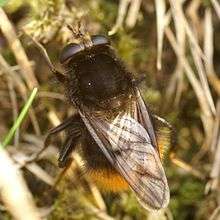Criorhina ranunculi
| Criorhina ranunculi | |
|---|---|
 | |
| Criorhina ranunculi | |
| Scientific classification | |
| Kingdom: | Animalia |
| Phylum: | Arthropoda |
| Class: | Insecta |
| Order: | Diptera |
| Family: | Syrphidae |
| Genus: | Criorhina |
| Species: | C. ranunculi |
| Binomial name | |
| Criorhina ranunculi (Panzer, 1804) | |
Criorhina ranunculi, is a species of hoverfly. It is found in the spring in many parts of Britain and Europe.[1]
The larvae of C. ranunculi are associated with rotting deciduous wood.[lower-alpha 1] Adults are remarkable bumblebee mimics and are usually found in woodland in springtime visiting flowers such as sallow to feed.[2][3]
Description
External images
For terms see Morphology of Diptera
Large (wing length 11·25-14 mm.) bumblebee mimic.Thorax and abdomen with long,
dense hairs.Hairs black on thorax and basal part of abdomen red or yellowish on tip of abdomen. Scutellar hairs may be pale yellow or brownish.Hind femora considerably thickened, especially in males. Hind tibiae sickle-shaped.[4]
[5]
[6] [7]
Distribution
Palaearctic.South Norway and South Sweden southwards to central Spain.Ireland eastwards through central Europe into European parts of Russia.[8] [9]
Biology
Habitat:Betula, Fagus and Quercus forest with overmature trees.[10] Adults are primarily arboreal, but descend to visit flowering shrubs in sun-lit glades. Flies extremely fast, with a highpitched whine, zig-zagging between the branches of flowering trees. Flowers visited include Cardamine pratensis, Cornus sanguinea, Crataegus, Photinia, Prunus cerasus, Prunus spinosa, Rubus, Salix, Sorbus aucuparia.[11] The flight period is from the beginning of March to mid May (later at higher altitudes).
See also
Other bumblebee mimics are Mallota, Arctophila, Merodon, Pocota and Brachypalpus.Criorhina differ from these genera in the form of the antennae.
Notes
- ↑ Despite the specific name, the species has no special association with Ranunculus buttercups.
References
- ↑ Stubbs, Alan E.; Falk, Steven J (1983). British Hoverflies: An Illustrated Identification Guide (2nd ed.). London: British Entomological and Natural History Society. pp. 253, xvpp. ISBN 1-899935-03-7.
- ↑ Ball, S.G.; Morris, R.K.A. (2000). Provisional atlas of British hoverflies (Diptera, Syrphidae). Monks Wood, UK: Biological Records Centre. pp. 167 pages. ISBN 1-870393-54-6.
- ↑ Rotheray G., 1993 Colour Guide to Hoverfly Larvae Diptera, Syrphidae in Britain and Europe Dipterists Forum pdf
- ↑ Van Veen, M. (2004) Hoverflies of Northwest Europe: identification keys to the Syrphidae. 256pp. KNNV Publishing, Utrecht.addendum
- ↑ Van der Goot,V.S. (1981) De zweefvliegen van Noordwest - Europa en Europees Rusland, in het bijzonder van de Benelux. KNNV, Uitgave no.32: 275pp. Amsterdam.
- ↑ Bei-Bienko, G.Y. & Steyskal, G.C. (1988) Keys to the Insects of the European Part of the USSR, Volume V: Diptera and Siphonaptera, Part I. Amerind Publishing Co., New Delhi. ISBN 81-205-0080-6.
- ↑ Coe, R.L. (1953) Diptera: Syrphidae. Handbks.ident.Br.insects, 10(1): 1-98. R.ent.Soc.London. pdf
- ↑ Fauna Europaea
- ↑ Peck, L.V. (1988) Syrphidae. In: Soos, A. & Papp, L. (eds.) Catalogue of Palaearctic Diptera, 8: 11-230. Akad.Kiado, Budapest.
- ↑ Speight, M.C.D. (2011). "Species accounts of European Syrphidae (Diptera)" (PDF). Syrph the Net, the database of European Syrphidae. 65: 285pp.
- ↑ de Buck, N. (1990) Bloembezoek en bestuivingsecologie van Zweefvliegen (Diptera, Syrphidae) in het bijzonder voor België. Doc.Trav. IRSNB, no.60, 1-167.